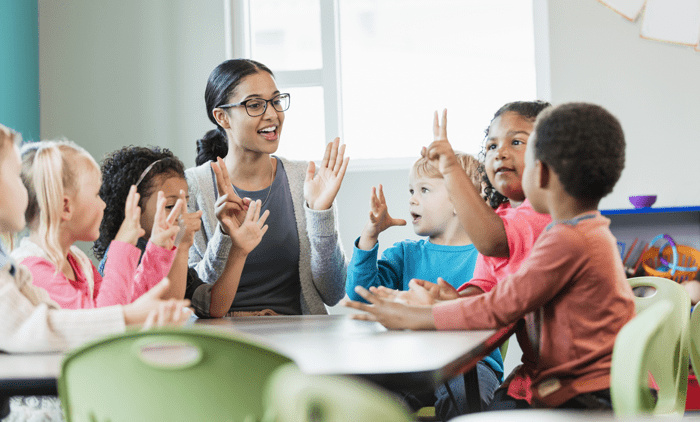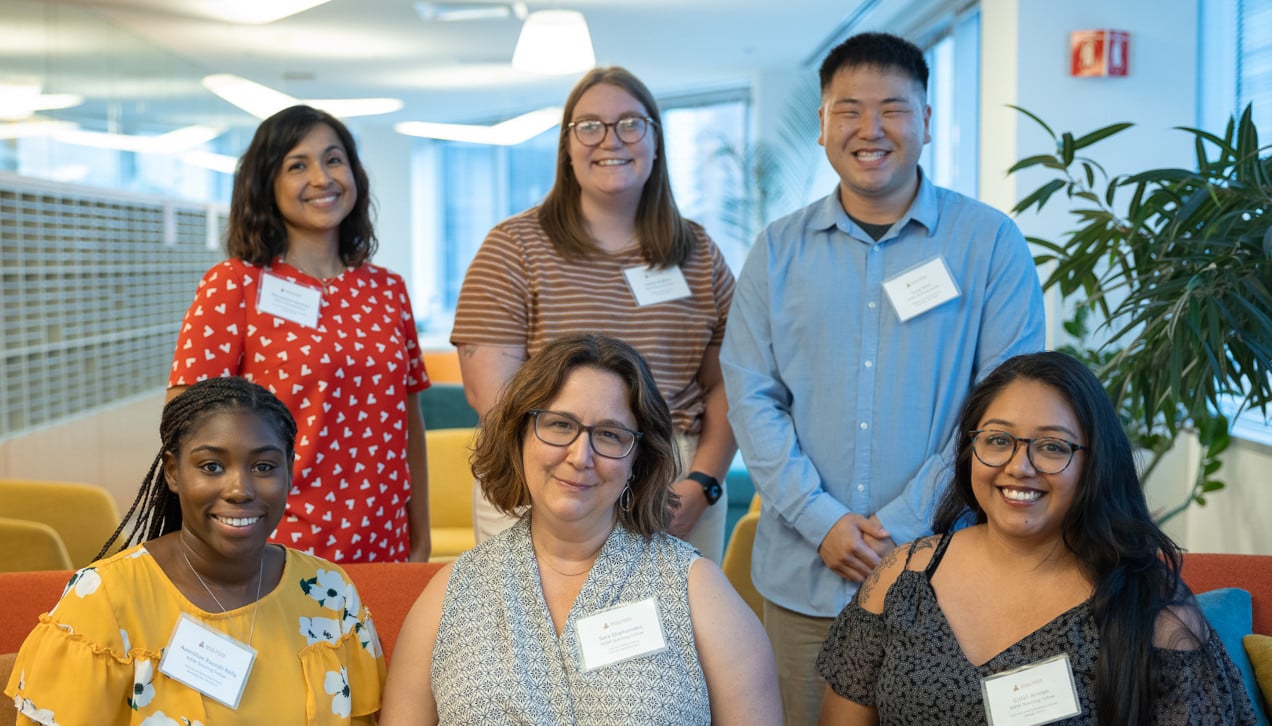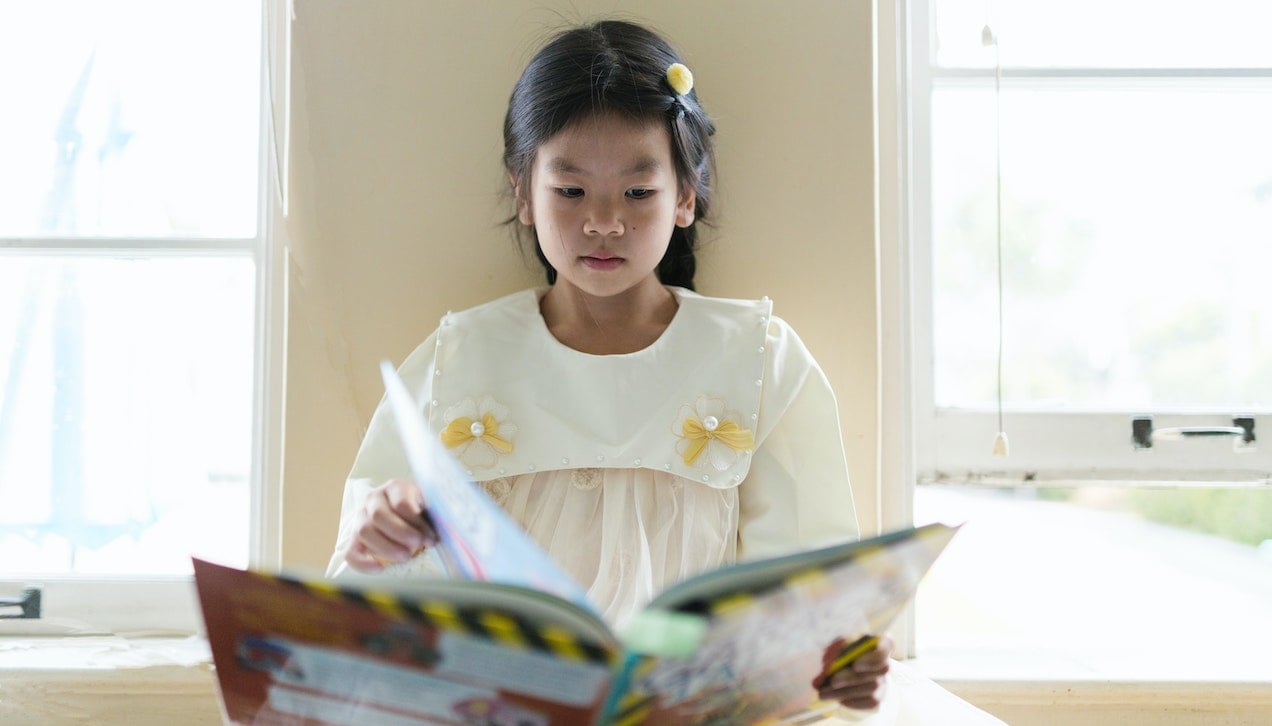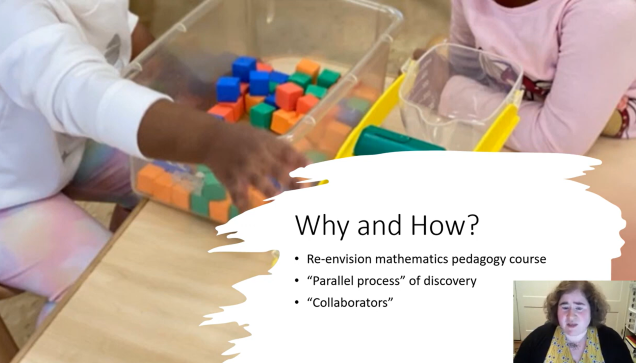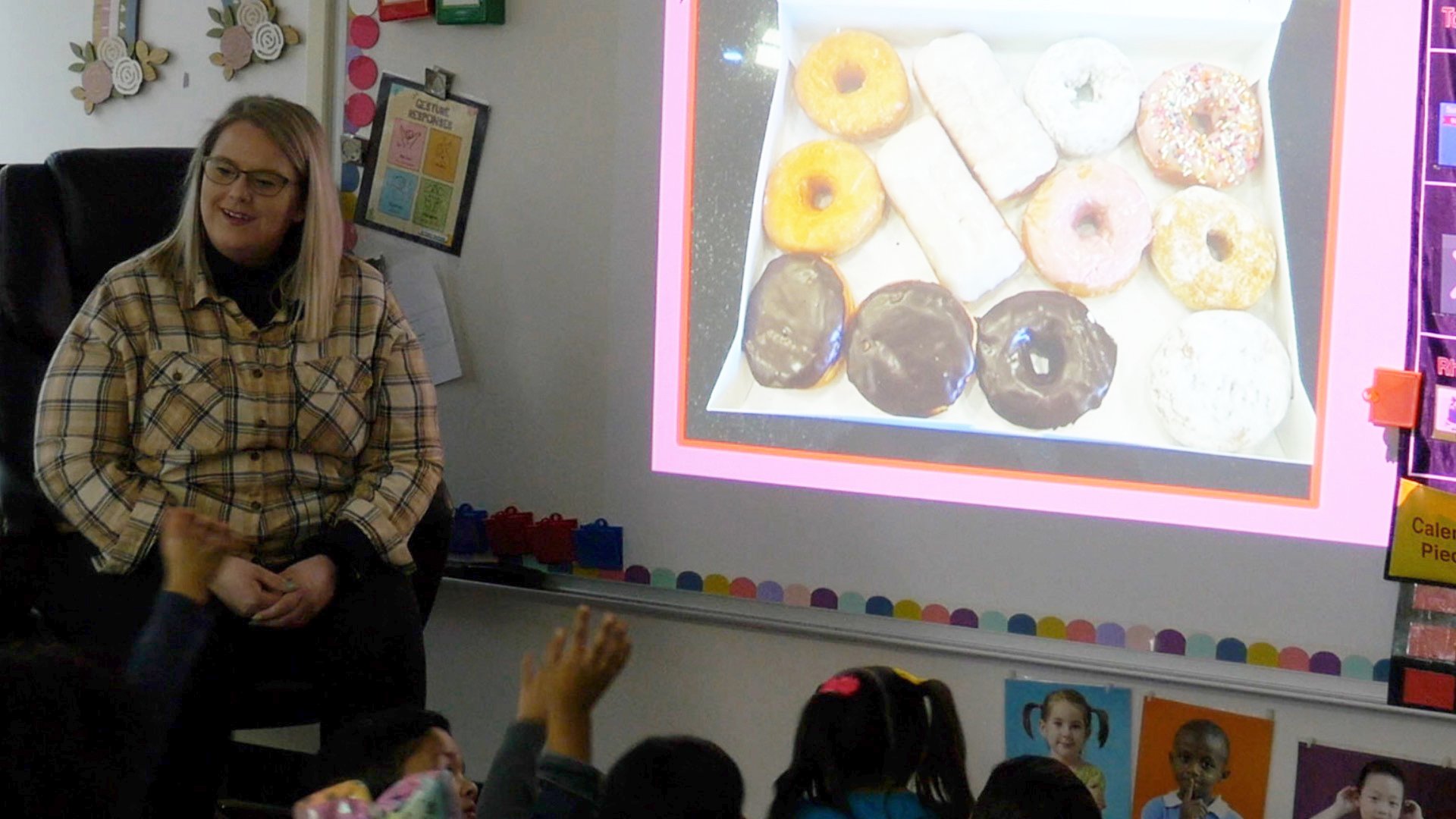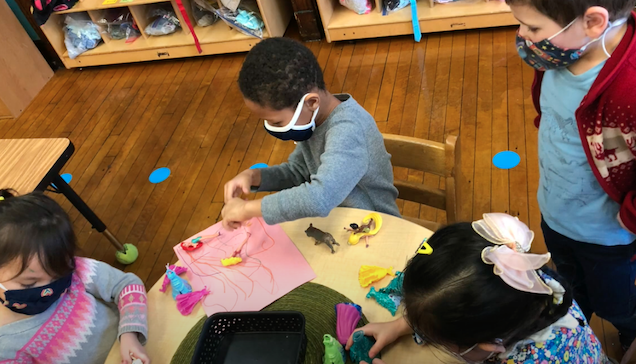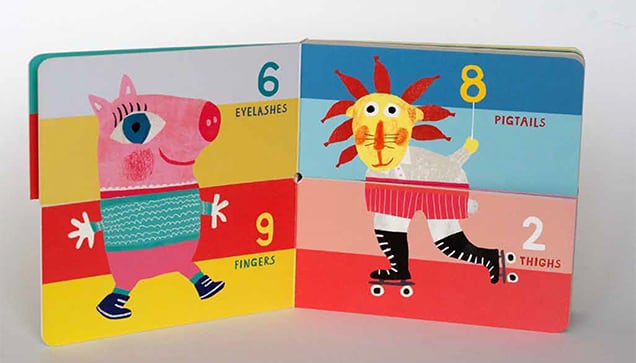Professional Learning Modules
Measurement
Instructions
Each module begins with an introduction video, and then a 20-30 minute presentation. After those are the complimentary videos and materials you see below, such as Focus on the Child videos and ideas to help you Look for Math All Around You. So please review the introductory video and text and launch the Measurement presentation when you are ready.
About this module
Measurement is any process that produces a quantitative description of an attribute, such as length, circumference, weight, temperature, volume, or number. Measurement is an essentially mathematical procedure that we apply in many different contexts. In our daily life, we often wish to know how many beats per measure, how many more minutes until preschool is over, how hot it is today, or whether I am taller than my friend. In all these circumstances, we use some kind of comparison process to measure or to answer the question “how much?” or “how many?” Attributes like length and capacity are more readily apparent and meaningful to young children than less visible ideas like temperature and time.
© Erikson Institute’s Early Math Collaborative. Reprinted from Big Ideas of Early Mathematics: What Teachers of Young Children Need to Know (2014), Pearson Education.
Focus on the Child
Focusing on children’s mathematical thinking is big.
These videos are taken from our Focus on the Child video series. They are one-on-one interviews with individual children. The interviews are designed to elicit evidence of children’s mathematical thinking. They are not teaching episodes or formal assessments.
Overall guiding questions as you watch them include:
- Where is the math?
- Which big ideas does this child understand?
- What evidence do you see of the child’s thinking?
- Where is this child along the developmental trajectory?
- How would you assist the child to enhance understanding?
Focus on the Lesson
Focusing on the lesson is big.
These videos are taken from our Focus on the Lesson video series. They represent planned activities for children designed to teach specific mathematical ideas that can compliment (not replace) existing math curricula. Overall guiding questions as you
watch the video includes:
- What evidence do you see of the children’s thinking?
- What evidence do you see of the teacher’s thinking?
- How might this experience connect to other math?

Just Right for Me: Details
Big Idea Focus: All measurement is comparison, and comparisons must be “fair.” All measurement is approximate.
In this lesson, children:
- Explore the attribute of length
- Make direct comparisons to find classroom objects that are about the same length as their hand
- Practice beginning measuring techniques
- Justify their findings to one another
Materials:
- A version of Goldilocks and the Three Bears tale
- Objects found in the classroom
Planning Tips
Read Five Creatures at least once prior to this lesson. It is best to introduce this activity with a group of about 10 children. Later, this is a good whole-group or transition activity. For example, call all children with tie shoes to line up,
then children wearing shoes with straps.
[two_third]
1. Review Goldilocks and Introduce Activity
Remind children of the tale of Goldilocks and the Three Bears. Ask children why they think that the Bear family’s things— porridge bowls, chairs, beds—all come in different sizes. Discuss how they know what things belong to Baby Bear. What size is “just
right” for Baby Bear? Tell children that today they will get to look around the classroom to find things that are “just right” in size for them.
2. Demonstrate How to Make Direct Comparisons
Ask children to search for things that are about the same length as their own hand. Choose a volunteer to model what they are going to do. For example, say:
- Let’s look at Della’s hand first. Where does her hand start? Where does her hand end? That is the length of her hand [wrist to tip of longest finger].
- Do you see anything in the room that might be about the same length as Della’s hand?
 Try out several suggestions from the group. Model how to line up the end of the classroom object with the base of the child’s hand. Determine together whether the object is the same length or not. Allow children to decide how precise is “just right”
enough to be considered the same length. Next, give children a few minutes to find and measure objects around the classroom with their hands to see if they can find any they believe are the same length.
3. Discuss Children’s Findings
Invite children to share what they found. Because children will find objects of various shapes, you may need to help them isolate the attribute of length. Help them line up the end of the objects with the base of their hands when comparing. Ask children
to justify their findings, for example:
- How did you decide if it was “just right?”
- How can you be sure it’s about the same length?
- How does it compare to the length of your hand?
- Did other children find the same objects as you did when they measured with their hand? Why or why not?
3. Close the Lesson
Remind children that to find a “just right” object for the length of their hand they need to compare it by lining up their hand with the object, end to end. Tell them that this works for other measurements of length, too. Plan to return to this activity
over time to provide additional opportunities for children to work with direct comparisons using other body measurements such as length of arm, foot, or hand span. [/two_third] [one_third_last]
Planning Tip
Make sure that children are familiar with the tale of Goldilocks and the Three Bears prior to this lesson. Introduce this lesson to small groups. Once children gain experience making direct comparisons, you may want to repeat the lesson at whole
group time with various other body measurements such as length of arm, foot, or hand span.
Math Language Learning
Model and encourage children to use attribute language that is specific to length: longer, taller, shorter, same length.
Observation
Do children try measuring objects that seem unlikely to be the length of their hand? Or, are they discriminating, measuring only those objects that are fairly close? Do they become more discriminating with experience?[/callout_box]
Observation
Can children focus on the attribute of length, or are they distracted by other size properties of an object such as width, depth, or weight?
Differentiation
As children are ready, you can ask them to look around the room for objects that are longer or shorter than the part of their body they are comparing. Ask children to share their findings so that they will have the opportunity to use comparative language
such as, The crayon is shorter than my hand. It is also important for children to express the inverse relationship: My hand is longer than the crayon. You may need to model the language for them. [/one_third_last]
Just Right for Me: Video

Questions to Answer
- using hands to compare
- explaining process with words & gestures
- changing idea with support
- doing activity with small group of children
- demonstrating length of hand with words and gestures
- “just right” applies to quantity, too
Look for Math All Around You
Helping children find math all around us is big.
Organized by different areas of the classroom, Math All Around You sections are meant to be idea generators. For each area, there are ideas of what children might be saying or doing mathematically and what teachers might say or do to build understanding. These are not intended to be checklists, but rather a jumping off point for discussion of how adults can “mathematize” the world around them.
Children's Literature: Measurement
Finding math in the books we read is big.
Finding great math is often best done in good books. This is not a list of books that explain math to children. They are books that are rich in mathematical possibilities and that can serve as jumping-off points for engaging math activities and math
discussions.
- Aber, L. Carrie Measures Up. Kane Press, 2001. Alborough, J. Tall. Candlewick Press, 2005.
- Alborough, J. Where’s My Teddy? Candlewick Press, 1992.
- Aylesworth, J. The Mitten. Scholastic Press, 2009. [Alternate versions of story by Brett & Tresselt.]
- Baker, K. Just How Long Can a Long String Be? Arthur A. Levine Books, 2004.
- Brett, J. The Mitten. G. P. Putnam’s Sons, 1989. [Alternate versions of story by Aylesworth & Tresselt.]
- Briggs, R. Jim and the Beanstalk. Scholastic, 1970.
- Burns, M. Spaghetti and Meatballs for All! Scholastic, 1997.
- Carle, E. The Grouchy Ladybug. HarperCollins, 1977.
- Carle, E. Papa, Please Get the Moon for Me. HarperCollins, 1986.
- dePaola, T. Strega Nona. Aladdin, 1975. [Alternate versions of story by DeSpain & Ziefert.]
- DeSpain, P. The Magic Pot. August House Story Cove, 2007. [Alternate versions of story by dePaola & Ziefert.]
- Ehlert, L. Un Lazo a la Luna / Moon Rope. Harcourt Brace Jovanovich, 1992. Florian, D. A Pig is Big. HarperCollins, 2000.
- Franco, B. Grandpa’s Quilt. Children’s Press, 1999. (link)
- Hoban, T. Is It larger? Is It smaller? Greenwillow, 1985.
- Jenkins, S. Actual Size. Houghton Mifflin, 2004. Jenkins, S. Big & Litlle. Houghton Mifflin, 1996. (link)
- Kalan, R. Blue Sea. Mulberry Books, 1979.
- Krauss, R. The Growing Story. HarperCollins, 2007/1947. Leedy, L. Measuring Penny. Square Fish, 1997.
- Lionni, L. Inch by Inch. HarperTrophy, 1960.
- Mosel, A. Tikki Tikki Tembo. Henry Holt, 1968.
- Myller, R. How big is a Foot? Yearling, 1962.
- Pinczes, E.J. Inchworm and a Half. Scholastic, 2001.
- Rathmann, P. 10 Minutes till Bedtime. Puffin, 1998.
- Rockliff, M. Next to an Ant. Children’s Press, 2004. [También en español: Al lado de una hormiga.]
- Rockwell, A. One Bean. Walker and Company, 1998.
- Russo, M. The Line Up Book. Greenwillow Books, 1986.
- Sweeney, J. Me and the Measure of Things. Dell Dragonfly Books, 2001.
- Tompert, A. Just a Little Bit. Houghton Mifflin, 1993.
- Tresselt, Al.R. The Mitten. Mulberry Books, 1964. [Alternate versions of story by Aylesworth & Brett.]
- Walsh, E.S. Balancing Act. Beach Lane, 2010.
- Wells, R.E. Is a Blue Whale the Biggest Thing There Is? Albert Whitman, 1993.
- Wells, R.E. What’s Smaller Than a Pygmy Shrew? Albert Whitman, 1995.
- Ziefert, H. The Magic Porridge Pot. Puffin Books, 1997. [Alternate versions of story by dePaola & DeSpain.]
Versions of Goldilocks & the Three Bears
- Aylesworth, J. Goldilocks and the Three Bears. Scholastic, 2003.
- Barton, B. The Three Bears. Harpercollins, 1991.
- Brett, J. Goldilocks and the Three Bears. G.P. Putnam’s Sons, 1987.
- Child, L. Goldilocks and the Three Bears. Disney Hyperion, 2008.
- Marshall, J. Goldilocks and the Three Bears. Puffin 1988.
- Ransom, C. Goldilocks and the Three Bears. School Specialty, 2005. [También en español: Ricitos de Oro y los tres osos.]
- Rosales, M.B. Leola and the Honeybears. Scholastic, 1999. Sanderson, R. Goldilocks. Little, Brown, 2009.
- Spirin, G. Goldilocks and the Three Bears. Marshall Cavendish, 2009.
Adult Learning Activities
Learning as an adult is big.
Adult Learning Activities are ways to get adults engaged in doing math as adults. While they involve basic math concepts, they are not children’s math that we are asking adults to do; nor are they activities to try with young children. They are designed so that they:
- are based on a central and coherent concept of the discipline being explored;
- pose a puzzle or problem;
- are interesting/non-routine enough to capture and retain adult attention;
- clearly focus thinking on the relevant content/ideas;
- are easy to implement in an adult PD setting;
- may have more than one solution or route to solution;
- set the stage for understanding foundational Big Ideas.
Related Ideas
What Do We Mean by Counting Principles and What Do Early Childhood Educators Need to Know?
Counting is a part of young children’s everyday life. They love to count everything from the stairs they climb to More →
- Series: Ideas at Work
RJEM Project Announces the 2023-24 Teaching Fellowship Cohort
In May of 2023, a diverse group of six kindergarten teachers from across the United States were selected from a More →
- Series: Racial Justice
The Power of Books to Support Racial Justice-Centered Math Teaching and Learning
From a racial justice centered perspective, books can be powerful tools to engage children in mathematics learning. The worlds, stories, More →
- Series: Racial Justice
- Age/Grade Level: Pre-K Kindergarten 1st Grade 2nd Grade 3rd Grade
Big Idea Talk and Play: Co-Discovering the Power of Open-Ended Math Exploration
RJEM at Work highlights the everyday efforts of caregivers, community organizations, teachers, researchers, and educational institutions to promote racial justice More →
- Series: Racial Justice
- Age/Grade Level: Adult Learners
Photo Chat about Quantities Puts the Focus on Units
In this video, preschoolers share the quantities they see when looking at a photo of a box of doughnuts. There are many ways to answer the question, how many of what?, depending on the unit.
- Series: Focus on the Lesson
- Topics: Number Sense Data Analysis
- Age/Grade Level: Pre-K Kindergarten 1st Grade
What is a Number Path and How Does It Build Number Relationships?
Many of children’s favorite board games follow a path to a goal. Exploring a number path with young children also More →
- Series: Ideas at Work
- Topics: Number Sense Counting
- Age/Grade Level: Pre-K Kindergarten 1st Grade
- Games
Fostering Racial Justice and Deep Mathematical Thinking in Chicago PreK
RJEM at Work highlights the everyday efforts of caregivers, community organizations, teachers, researchers, and educational institutions to promote racial justice More →
- Series: Racial Justice
- Age/Grade Level: Adult Learners
4 Playful Counting Books That Bring Numbers to Life
Counting books that offer children opportunities to participate bring play into math learning. These books engage children physically, cognitively, and emotionally—making them favorites that children will ask to read again and again.
- Series: Book Ideas
- Topics: Number Sense
- Age/Grade Level: Pre-K Kindergarten 1st Grade
- Family Math




